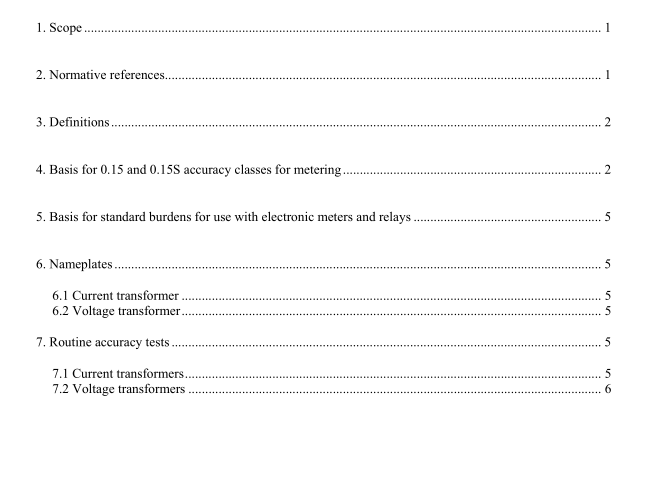IEEE C57.13.6-2005 pdf download.IEEE Standard for High-Accuracy Instrument Transformers
This standard defines one new 0.15 accuracy class for voltage transformers, two new 0.15 accuracy classes for current transformers, two new current transformer burdens, and two new current transformer routine accuracy test methods. These supplement IEEE Std C57.13™ 1 .
The new burdens shall be considered for use when current transformers are to be used with electronic meters, and the total in-circuit burden will be less than B-0.1 (2.5 VA at 5 A, 0.9 power factor) defined in IEEE Std C57.13. The new accuracy classes, 0.15 and 0.15S, are available to complement the capabilities of solid state electricity metering of equipment associated with the generation, transmission, and distribution of alternating current. T
here are two important differences about these new accuracy class definitions as they apply to routine current transformer test requirements: A low current test is required at 5% of rated current (0.25 A secondary), in lieu of the 10% of rated current test specified in IEEE Std C57.13. This test point corresponds with the light load test point of transformer rated electromechanical and solid state electricity meters as specified in ANSI C12.20. Routine testing for current transformers certified to meet 0.15 or 0.15S accuracy must include accuracy reading(s) using new burden definition E-0.04.
The intent of burden E-0.04 (1.0 VA at 5 A, unity power factor) is to approximate the lowest secondary circuit burden that can occur in practical applications. Testing a current transformer at this burden is analogous to the routine no-load voltage transformer test required by IEEE Std C57.13. Normative references The following referenced documents are indispensable for the application of this document. For dated references, only the edition cited applies. For undated references, the latest edition of the referenced document (including any amendments or corrigenda) applies.
ANSI C12.10, American National Standard Physical Aspects of Watthour Meters—Safety Standards. 2
ANSI C12.20, American National Standard Electricity Meters 0.2 and 0.5 Accuracy Classes.
IEEE Std C57.13, IEEE Standard Requirements for Instrument Transformers
Definitions All definitions shall be in accordance with IEEE 100, The Authoritative Dictionary of IEEE Standards Terms, and IEEE Std C57.13 . Basis for 0.15 and 0.15S accuracy classes for metering The 0.15 and 0.15S accuracy classes are based on the requirement that the transformer correction factor (TCF) of the voltage or current transformer shall be within the specified limits of Table 1 when the power factor of the metered load has any value from 0.6 lagging to unity, under the following specified conditions: For current transformers, burden E-0.04, and each additional specified standard burden, at 5% and at 100% of rated primary current, and at the current corresponding to the continuous thermal rating factor (RF), if it is greater than 1.0.
The accuracy class at a lower standard burden is not necessarily the same as at the specified standard burden. For voltage transformers, from 0 VA through the specified standard burden, and from 90% to 110% of the rated voltage.
The accuracy class at a lower standard burden of different power factor is not necessarily the same as at the specified standard burden.
Basis for standard burdens for use with electronic meters and relays Electronic meters, relays, and connecting circuits may present a lower burden or lower burden phase angle to the secondary of the current transformer than standard burdens defined in IEEE Std C57.13. An instrument transformer meeting a given accuracy class at burden B0.1 may not meet the same accuracy class when the application calls for a burden power factor between 0.9 and unity, and or less than 2.5 VA (at 5 A).
Two standard ‘E’ burdens for current transformers with 5 A rated secondary are defined in Table 2. These may be used with, or in addition to, burdens and accuracy classes defined in IEEE Std C57.13.IEEE C57.13.6 pdf download.IEEE C57.13.6-2005 pdf download
IEEE C57.13.6-2005 pdf download

Leave a Reply